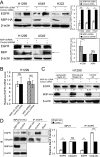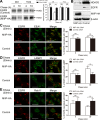MIIP accelerates epidermal growth factor receptor protein turnover and attenuates proliferation in non-small cell lung cancer
- PMID: 26824318
- PMCID: PMC4891030
- DOI: 10.18632/oncotarget.7001
MIIP accelerates epidermal growth factor receptor protein turnover and attenuates proliferation in non-small cell lung cancer
Abstract
The migration and invasion inhibitory protein (MIIP) has been discovered recently to have inhibitory functions in cell proliferation and migration. Overexpression of MIIP reduced the intracellular steady-state level of epidermal growth factor receptor (EGFR) protein in lung cancer cells with no effect on EGFR mRNA expression compared to that in the control cells. This MIIP-promoted EGFR protein degradation was reversed by proteasome and lysosome inhibitors, suggesting the involvement of both proteasomal and lysosomal pathways in this degradation. This finding was further validated by pulse-chase experiments using 35S-methionine metabolic labeling. We found that MIIP accelerates EGFR protein turnover via proteasomal degradation in the endoplasmic reticulum and then via the lysosomal pathway after its entry into endocytic trafficking. MIIP-stimulated downregulation of EGFR inhibits downstream activation of Ras and blocks the MEK signal transduction pathway, resulting in inhibition of cell proliferation. The negative correlation between MIIP and EGFR protein expression was validated in lung adenocarcinoma samples. Furthermore, the higher MIIP protein expression predicts a better overall survival of Stage IA-IIIA lung adenocarcinoma patients who underwent radical surgery. These findings reveal a new mechanism by which MIIP inhibits cell proliferation.
Keywords: epidermal growth factor receptor; migration and invasion inhibitory protein; non-small cell lung cancer; protein degradation.
Conflict of interest statement
The authors declare no conflict of interest.
Figures






Similar articles
-
Reciprocal Negative Regulation between EGFR and DEPTOR Plays an Important Role in the Progression of Lung Adenocarcinoma.Mol Cancer Res. 2016 May;14(5):448-57. doi: 10.1158/1541-7786.MCR-15-0480. Epub 2016 Feb 19. Mol Cancer Res. 2016. PMID: 26896556
-
Cell proliferation and epidermal growth factor signaling in non-small cell lung adenocarcinoma cell lines are dependent on Rin1.J Biol Chem. 2009 Sep 25;284(39):26331-9. doi: 10.1074/jbc.M109.033514. Epub 2009 Jul 1. J Biol Chem. 2009. PMID: 19570984 Free PMC article.
-
Upregulation of MIIP regulates human breast cancer proliferation, invasion and migration by mediated by IGFBP2.Pathol Res Pract. 2019 Jul;215(7):152440. doi: 10.1016/j.prp.2019.152440. Epub 2019 May 6. Pathol Res Pract. 2019. PMID: 31078343
-
MIIP, a cytoskeleton regulator that blocks cell migration and invasion, delays mitosis, and suppresses tumorogenesis.Curr Protein Pept Sci. 2011 Feb;12(1):68-73. doi: 10.2174/138920311795659434. Curr Protein Pept Sci. 2011. PMID: 21190522 Review.
-
Control of cell metabolism by the epidermal growth factor receptor.Biochim Biophys Acta Mol Cell Res. 2022 Dec;1869(12):119359. doi: 10.1016/j.bbamcr.2022.119359. Epub 2022 Sep 9. Biochim Biophys Acta Mol Cell Res. 2022. PMID: 36089077 Review.
Cited by
-
MIIP remodels Rac1-mediated cytoskeleton structure in suppression of endometrial cancer metastasis.J Hematol Oncol. 2016 Oct 19;9(1):112. doi: 10.1186/s13045-016-0342-6. J Hematol Oncol. 2016. PMID: 27760566 Free PMC article.
-
Cucurbitacin B Induces the Lysosomal Degradation of EGFR and Suppresses the CIP2A/PP2A/Akt Signaling Axis in Gefitinib-Resistant Non-Small Cell Lung Cancer.Molecules. 2019 Feb 12;24(3):647. doi: 10.3390/molecules24030647. Molecules. 2019. PMID: 30759826 Free PMC article.
-
MIIP inhibits the growth of prostate cancer via interaction with PP1α and negative modulation of AKT signaling.Cell Commun Signal. 2019 May 15;17(1):44. doi: 10.1186/s12964-019-0355-1. Cell Commun Signal. 2019. PMID: 31092266 Free PMC article.
-
Histone deacetylase 6 in cancer.J Hematol Oncol. 2018 Sep 3;11(1):111. doi: 10.1186/s13045-018-0654-9. J Hematol Oncol. 2018. PMID: 30176876 Free PMC article. Review.
-
MIIP is downregulated in gastric cancer and its forced expression inhibits proliferation and invasion of gastric cancer cells in vitro and in vivo.Onco Targets Ther. 2018 Dec 11;11:8951-8964. doi: 10.2147/OTT.S173393. eCollection 2018. Onco Targets Ther. 2018. PMID: 30588008 Free PMC article.
References
-
- Torre LA, Bray F, Siegel RL, Ferlay J, Lortet-Tieulent J, Jemal A. Global cancer statistics, 2012. CA Cancer J Clin. 2015;65:87–108. - PubMed
-
- Hirsch FR, Varella-Garcia M, Cappuzzo F. Predictive value of EGFR and HER2 overexpression in advanced non-small-cell lung cancer. Oncogene. 2009;28(Suppl 1):S32–37. - PubMed
Publication types
MeSH terms
Substances
LinkOut - more resources
Full Text Sources
Other Literature Sources
Medical
Research Materials
Miscellaneous

